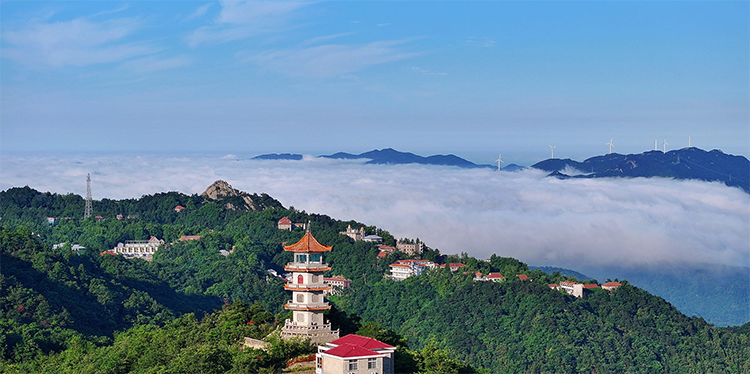Sea of Clouds at Jigong Mountain: Sunrise Views & Historic Villas
Nestled in southern Henan near the border with Hubei, Jigong Mountain (Jigongshan) rises like a rooster calling the dawn. This national 5A scenic area blends dramatic peaks, cloud seas, dense forests, and century-old architecture. With 98% vegetation coverage and more than 300 villas in varied international styles, it’s both a natural oxygen bar and a living museum of modern Chinese history.
1. Core Features: Majestic Scenery and Century-Old Architecture
Jigong Mountain’s soul is a gift of both nature and culture. The main summit, Baoxiao Peak (elevation 768 m), resembles a rooster crowing at sunrise—climb it to overlook rolling seas of cloud and epic sunrises. In the late Qing and Republican eras, foreign missionaries and visitors built summer homes here; villas reflecting the architectural styles of 23 countries scatter through the woods, earning the area the nickname “Museum of International Architecture.”
Unique selling points:
– North–South plant gene pool: Over 2,000 plant species meet here, making the mountain a natural laboratory for the transition zone between northern and southern Chinese flora.
– Four-season appeal: Average summer temperature about 23°C; crystalline rime in winter; spring wildflowers; autumn forests ablaze with color.
– Living historical relics: From Ming-era beginnings to wartime sites, every villa and stone stairway tells a story of the past century.
2. Natural Wonders: Sea of Clouds, Sunrise and Pristine Gorges
Baoxiao Peak: One Crow of Dawn, A World Revealed
Baoxiao Peak is the signature viewpoint for watching the sea of clouds and sunrise. Early mornings see fog rise from the valleys like waves; when the sun breaks through, golden light floods the ridgelines and creates a surreal scene. After rain, photographers may be rewarded with a rare “Buddha’s light” halo.
Changsheng Valley: An Untouched Ecological Haven
This less-developed canyon features hanging waterfalls, deep pools, and clear streams—perfect for hikers. Look for rare plants such as yew and Davidia involucrata (handkerchief tree), and you might spot squirrels, thrushes, and other wildlife.
Best times and weather notes:
– Summer (May–October): Ideal for cooling off; frequent mists and pleasant temperatures.
– Winter (December–February): Frost-covered branches create a silver wonderland.
– After rain or at dawn: Highest chance to see the famous sea of clouds—must-visit for photographers.

3. Cultural Treasures: International Villas and Wartime Relics
Yilu: A Blend of East and West
Yilu is a luxurious Republican-era villa built by warlord Jin Yun’e. It combines traditional Chinese flying eaves with Western arched windows and colonnades—an architectural highlight of Jigong Mountain.
Air-Raid Tunnels: Silent Witnesses of War
The park preserves complex wartime air-raid tunnels and shelters carved during the Anti-Japanese War. These underground networks are poignant historical sites for visitors interested in 20th-century Chinese history.
The 23-Nation Villa Cluster: A Miniature Global Panorama
From Gothic chapels and American wooden cottages to Russian estates and Japanese gardens, more than 300 villas in diverse styles are tucked into the forest. Walking among them feels like stepping into an international community of the early 1900s.
4. Visitor Guide: How to Make the Most of Jigong Mountain
Transport:
– By car: From Xinyang city center, take the G40 Hushan Expressway to the Jigong Mountain exit—about a one-hour drive.
– By public transit: Tourist shuttle buses run from Xinyang Railway Station directly to the park (roughly 1.5 hours).
Recommended itineraries:
– One-day highlights: Baoxiao Peak (sunrise) → Changsheng Valley (hike) → Yilu (architecture) → Air-raid tunnels (history).
– Two-day deep dive: Day one covers key sights; day two explores scattered villas and enjoys Xinyang Maojian tea at an evening resort.

Who will enjoy it:
– Families: Sightseeing buses reduce long walks and make the park family-friendly.
– Photographers: Sea-of-clouds, sunrises, and historic villas offer abundant subjects.
– History and architecture buffs: The villa cluster and wartime relics provide deep cultural value.
5. Practical Information
– Entrance fee: ¥60 (includes major sites such as Changsheng Valley and Baoxiao Peak).
– Opening hours: 08:00–17:30 (arrive before 07:00 if you plan to watch sunrise).
– Food: Mountain inns and farmhouse restaurants serve local specialties like Xinyang stews and Nanwan fish.
– Accommodation: Several summer resorts and guesthouses are available; summer bookings recommended in advance.
Conclusion: An Immersive Journey Through Nature and History
Jigong Mountain is more than a peak—it’s a three-dimensional history book and a living landscape painting. Whether you come to cool off, study architecture, chase light with your camera, or simply escape the city, Jigong Mountain offers an unforgettable blend of natural beauty and cultural depth. Pack your bag, listen for the rooster’s call at dawn, and walk through a century of stories.


